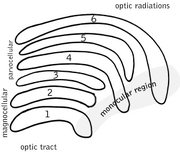No edit summary |
No edit summary |
||
| (One intermediate revision by the same user not shown) | |||
| Line 1: | Line 1: | ||
{{BioPsy}} |
{{BioPsy}} |
||
| + | {{distinguish|Magnocellular neurosecretory cell}} |
||
| − | '''Magnocellular parts''', also called '''M cells''', are cells in the [[brain]] concerned primarily with [[visual perception]]. In particular these cells are responsible for resolving motion and coarse outlines. The cells have large, fast-conducting [[neuron]]s and transmit information to the [[lateral geniculate nucleus]], the area of the brain responsible for analyzing and interpreting the information. This system of cells operates with great speed at the expense of detail. |
||
| + | {{about|the lateral geniculate nucleus cell|the part of the red nucleus|Magnocellular red nucleus}} |
||
| + | {{Infobox neuron |
||
| + | |neuron_name = Magnocellular cell |
||
| + | |image_neuron = |
||
| + | |caption_neuron = |
||
| + | |location = |
||
| + | |function = |
||
| + | |neurotransmitter = |
||
| + | |morphology = |
||
| + | |afferents = |
||
| + | |efferents = |
||
| + | |NeuroLex = Magnocellular cell |
||
| + | |NeuroLexID = nifext_42 |
||
| + | }} |
||
| + | '''Magnocellular cells''', also called '''M-cells''', are [[neuron]]s located within the magnocellular layer of the [[lateral geniculate nucleus]] of the [[thalamus]]. The cells are part of the [[visual system]]. They are termed "magnocellular" since they are characterized by their relatively large size compared to [[parvocellular cells]]. |
||
| + | |||
| + | ==Visual system== |
||
| + | [[Image:lateral geniculate nucleus.png|thumb|Schematic diagram of the primate LGN.]] |
||
| + | Magnocellular cells are primarily concerned with [[visual perception]].<ref name="pmid11179404">{{cite journal |author=Xu X, Ichida JM, Allison JD, Boyd JD, Bonds AB, Casagrande VA |title=A comparison of koniocellular, magnocellular and parvocellular receptive field properties in the lateral geniculate nucleus of the owl monkey (Aotus trivirgatus) |journal=J. Physiol. (Lond.) |volume=531 |issue=Pt 1 |pages=203–18 |year=2001 |month=February |pmid=11179404 |pmc=2278453 |doi= |url=http://www.jphysiol.org/cgi/pmidlookup?view=long&pmid=11179404}}</ref> In particular these cells are responsible for resolving motion and coarse outlines. The M-cells receive their information from the axons of [[parasol cell]]s exiting the [[optic tract]]. The M-cells are large, fast-conducting [[neuron]]s with their cell bodies located in the 2 ventral magnocellular layers of the [[lateral geniculate nucleus]]. The information they carry is sent through the [[optic radiation]]s to the visual cortices, possibly after editing and gating by visual cortex exerting top-down control. The M-cells feed more to the parietal cortices, in the dorsal "where" stream, than the temporal cortices, destination of the ventral "what" stream. This is consistent with their coding of movement and edges as opposed to fine detail. This system of cells operates with great speed at the expense of detail. |
||
==See also== |
==See also== |
||
| − | * [[ |
+ | * [[Parvocellular cell]] |
| − | * [[ |
+ | * [[Koniocellular cell]] |
* [[Magnocellular pathway]] |
* [[Magnocellular pathway]] |
||
==References== |
==References== |
||
| + | {{reflist}} |
||
| + | |||
| + | ==External links== |
||
| + | * [http://www.neuinfo.org/nif/nifgwt.html?query=%22Magnocellular%20Cell%22 NIF Search - Magnocellular Cell] via the [[Neuroscience Information Framework]] |
||
| − | [[Category:lateral geniculate nucleus]] |
||
[[Category:Visual system]] |
[[Category:Visual system]] |
||
| + | |||
| − | [[Category:Visual perception]] |
||
| + | {{enWP|Magnocellular cells}} |
||
Latest revision as of 12:10, 21 August 2012
Assessment |
Biopsychology |
Comparative |
Cognitive |
Developmental |
Language |
Individual differences |
Personality |
Philosophy |
Social |
Methods |
Statistics |
Clinical |
Educational |
Industrial |
Professional items |
World psychology |
Biological: Behavioural genetics · Evolutionary psychology · Neuroanatomy · Neurochemistry · Neuroendocrinology · Neuroscience · Psychoneuroimmunology · Physiological Psychology · Psychopharmacology (Index, Outline)
- Not to be confused with Magnocellular neurosecretory cell.
- This article is about the lateral geniculate nucleus cell. For the part of the red nucleus, see Magnocellular red nucleus.
| Magnocellular cell |
|---|
Magnocellular cells, also called M-cells, are neurons located within the magnocellular layer of the lateral geniculate nucleus of the thalamus. The cells are part of the visual system. They are termed "magnocellular" since they are characterized by their relatively large size compared to parvocellular cells.
Visual system

Schematic diagram of the primate LGN.
Magnocellular cells are primarily concerned with visual perception.[1] In particular these cells are responsible for resolving motion and coarse outlines. The M-cells receive their information from the axons of parasol cells exiting the optic tract. The M-cells are large, fast-conducting neurons with their cell bodies located in the 2 ventral magnocellular layers of the lateral geniculate nucleus. The information they carry is sent through the optic radiations to the visual cortices, possibly after editing and gating by visual cortex exerting top-down control. The M-cells feed more to the parietal cortices, in the dorsal "where" stream, than the temporal cortices, destination of the ventral "what" stream. This is consistent with their coding of movement and edges as opposed to fine detail. This system of cells operates with great speed at the expense of detail.
See also
- Parvocellular cell
- Koniocellular cell
- Magnocellular pathway
References
- ↑ Xu X, Ichida JM, Allison JD, Boyd JD, Bonds AB, Casagrande VA (February 2001). A comparison of koniocellular, magnocellular and parvocellular receptive field properties in the lateral geniculate nucleus of the owl monkey (Aotus trivirgatus). J. Physiol. (Lond.) 531 (Pt 1): 203–18.
External links
| This page uses Creative Commons Licensed content from Wikipedia (view authors). |